Girl of the Golden West Study Guide (page 2)
Opera Production
Opera is created by the combination of myriad art forms. First and foremost are
the actors who portray characters by revealing their thoughts and emotions
through the singing voice. The next very important component is a full symphony
orchestra that accompanies the singing actors and actresses, helping them to
portray the full range of emotions possible in the operatic format. The
orchestra performs in an area in front of the singers called the orchestra pit
while the singers perform on the open area called the stage. Wigs, costumes,
sets and specialized lighting further enhance these performances, all of which
are designed, created, and executed by a team of highly trained artisans.
The creation of an opera begins with a dramatic scenario crafted by a playwright
or dramaturg who alone or with a librettist fashions the script or libretto that
contains the words the artists will sing. Working in tandem, the composer and
librettist team up to create a cohesive musical drama in which the music and
words work together to express the emotions revealed in the story. Following the
completion of their work, the composer and librettist entrust their new work to
a conductor who with a team of assistants (repetiteurs) assumes responsibility
for the musical preparation of the work. The conductor collaborates with a stage
director (responsible for the visual component) in order to bring a performance
of the new piece to life on the stage. The stage director and conductor form the
creative spearhead for the new composition while assembling a design team which
will take charge of the actual physical production.
Set designers, lighting designers, costume designers, wig and makeup designers
and even choreographers must all be brought “on board” to participate in the
creation of the new production. The set designer combines the skills of both an
artist and an architect using “blueprint” plans to design the actual physical
set which will reside on the stage, recreating the physical setting required by
the storyline. These blueprints are turned over to a team of carpenters who are
specially trained in the art of stage carpentry. Following the actual building
of the set, painters following instructions from the set designers’ original
plans paint the set. As the set is assembled on the stage, the lighting designer
works with a team of electricians to throw light onto both the stage and the set
in an atmospheric as well as practical way. Using specialized lighting
instruments, colored gels and a state of the art computer, the designer along
with the stage director create a “lighting plot” by writing “lighting cues”
which are stored in the computer and used during the actual performance of the
opera.
During this production period, the costume designer in consultation with the
stage director has designed appropriate clothing for the singing actors and
actresses to wear. These designs are fashioned into patterns and crafted by a
team of highly skilled artisans called cutters, stitchers, and sewers. Each
costume is specially made for each singer using his/her individual measurements.
The wig and makeup designer, working with the costume designer, designs and
creates wigs which will complement both the costume and the singer as well as
represent historically accurate “period” fashions.
As the actual performance date approaches, rehearsals are held on the newly
crafted set, combined with costumes, lights, and orchestra in order to ensure a
cohesive performance that will be both dramatically and musically satisfying to
the assembled audience.
Vocabulary
Aria (noun) a melody, from opera or oratorio sung by one singer.
Bravo (interjection) Italian, meaning "well done," used for a single male performer. "Brava" is used for a single female, and "bravi" is used for more than two people singing together.
Conductor (noun) the person who leads the singers and orchestra.
Ensemble (noun) a musical passage or piece of music in which more than one performer of equal importance participates at the same time. A group of musicians.
Libretto (noun) the text (words) of an opera.
Librettist (noun) the person who writes the words for an opera.
Opera (noun) a play told through singing.
Recitative (reh-sit-ah-teev) English adaptation from the Italian recitativo (noun) a type of speech-like singing that allows a degree of rhythmic freedom in performance. It is generally accompanied by orchestra, or harpsichord, but can be accompanied by other instruments capable of harmonic support, such as harp or guitar.
Repertoire (rep-er-twar) French (noun) the body of literature that is available for performance.
Score (noun) the written music of a musical composition, such as an opera
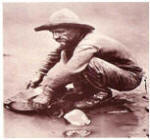 Casting for Rimrock Opera’s
Girl of the Golden West
Casting for Rimrock Opera’s
Girl of the Golden West
Ashby-Wells Fargo agent-bass-Dennis Rupp (from Burbank, CA)
Handsome-baritone-Christopher Holmes (from Salt Lake City)
Billy Jackrabbit-a Red Indian-bass- Bret Weston (from Billings)
Castro-a member of Ramirrez's gang-bass-Nathan Raschkow (from Billings)
Dick Johnson a.k.a. Ramirrez-a bandit-tenor-Randy Locke (from Sarasota, FL)
Happy-baritone-Dan Miller (from Billings)
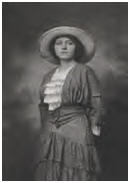 Jack
Rance-sheriff-baritone-Jason Detwiler (from Boise, ID)
Jack
Rance-sheriff-baritone-Jason Detwiler (from Boise, ID)
Jake Wallace-a minstrel-baritone-Aaron Pagniano (from Billings)
Joe-tenor-Josh Shaw (originally from Billings, coming from Burbank, CA)
Larkens-bass-Robert Aaron Taylor (from San Diego, CA)
Minnie-keeper of the Saloon-soprano-Paula Goodman Wilder (from San Francisco, CA)
Nick-bartender at the Saloon-baritone-Gennard Lombardozzi (from New Haven, CT)
Pony Express riders-Brooke Newell, Christina Pezzarossi, Megan Dolezal & Tessa Shelton (all from Billings)
Sid-baritone-Igor Vieria (from San Francisco, CA)
Card Dealer-non-singing role-Robert Port (from Billings)
Sonora-baritone-Christopher Holmes (coming from Salt Lake City, UT)
Trin-tenor-Scott Wichael (coming from Kansas City, KS)
Conductor-Andy Anderson (from Kansas City, KS)
Stage Director-Douglas Nagel (from Billings)
Stage Manager-Amy Logan (from Billings)
Rehearsal Pianist-Sandi Rabas (from Billings)
Costume Designer-Jill Port (from Billings)
Set Designer-Jean-François Revon (from Oakland, CA)
Set Construction-American Musical Theater (San José, CA)
The Opera’s background
After the success of Madame Butterfly, Puccini spent several years looking for a subject for his next opera. He considered a number of stories, including Hugo's The Hunchback of Notre Dame, but remained unsatisfied. During this period, he was also traveling extensively to attend performances of his works worldwide. In 1907, he was in New York to see the American premieres of Manon Lescaut and Madame Butterfly. While in the city, he attended a performance of The Girl of the Golden West, a play by David Belasco, who had also written the play on which Madame Butterfly, was based. Excited by the idea of doing another opera on an "exotic" subject, he decided this would be his next opera.
A number of circumstances interrupted the composition of The Girl of the Golden West. His librettists didn't work quite as quickly as he would have liked, slowing his progress. In addition, his family encountered a personal tragedy when a servant girl committed suicide in response to the unfounded jealousy of Puccini's wife. However, three years after his trip to New York, Fanciulla was completed.
Musically, Girl of the Golden West is one of Puccini's most innovative pieces. To an extent not seen in his earlier operas, he experiments with new harmonies and orchestration techniques. The work presents a challenge to both performers and directors in the sheer complexity of the onstage action. More so even than Tosca, this opera requires that its lead singers also be first-rate actors.
Girl of the Golden West was premiered at the Metropolitan Opera in New York on December 10, 1910, under the baton of Arturo Toscanini. The New York audience received the piece with great enthusiasm.
Original Set Design
Designer Jean-François Revon has been hired by Rimrock Opera to design and oversee building of a new, original set design of the opera.
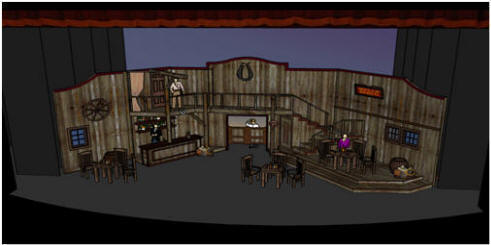
Act
Two – Minnie’s Cabin
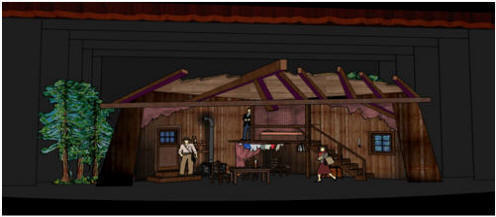
Act Three – Camp Street
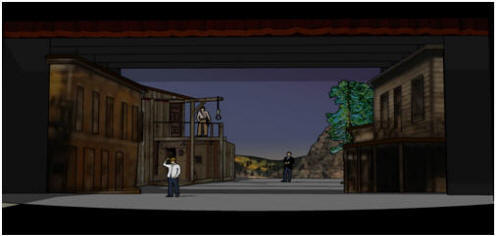
Following the discovery of gold in California in 1848, the world rushed in. Eager gold seekers headed south from Oregon; north from Mexico, Chile, and Peru; east from China and the islands of the Pacific; and west from every state in the union and countries throughout Europe. This richness of intersecting frontiers produced the most ethnically diverse region in the nation.
Gold-rush California also became a region noted for its ethnic conflict. Frustrated ambitions of unsuccessful gold seekers were vented in an almost unending round of ethnic hostilities. Scapegoats were eagerly sought, identified with lightning speed, and dispatched with little regret.
Native American miners were forced to abandon the diggings, and many fell victim to genocidal campaigns. The destruction of the ranchos dispossessed members of the old rancho elite, and Latino miners endured violent opposition as well as discriminatory taxes. French miners, derided as Keskydees, bitterly complained when they too were compelled to pay extra fees as foreign miners. Hawaiians in the gold fields were commonly called Kanakas. Chinese immigrants came seeking their fortune in the fabled land known as Gam Saan. African Americans were a small minority in gold-rush California and they too were bounded by unfair laws and practices.
Native American Miners
The discovery of gold brought hundreds of thousands of newcomers onto the lands of the California Indians. The native people responded in a variety of ways. Many retreated into the interior as their homelands were invaded by the flood of gold seekers. Others, especially among the Miwok and Yokuts in the Central Valley, raided the settlements of the newcomers for horses and other livestock.
Many native people joined in the rush for gold and became miners themselves.
Colonel Richard B. Mason estimated in 1848 that more than half the gold diggers
during the first year of the gold rush were Indians. Miwok prospectors and
miners, for instance, helped open the extraordinary riches of the southern
mines. At first, many Indian miners
worked as laborers for white Californians, often in a state of peonage similar
to their status on the Mexican
 ranchos. Others labored as independent agents and
traded their gold to white merchants for a variety of goods. In the early days,
California Indians were unaware of the true value of the gold they were trading,
and the whites competed with one another in cheating them. A common practice was
to trade glass beads to Indian miners for gold, weight for weight. But soon the
native miners developed a finer appreciation of the white man's high regard for
gold and became increasingly able and sophisticated traders themselves.
ranchos. Others labored as independent agents and
traded their gold to white merchants for a variety of goods. In the early days,
California Indians were unaware of the true value of the gold they were trading,
and the whites competed with one another in cheating them. A common practice was
to trade glass beads to Indian miners for gold, weight for weight. But soon the
native miners developed a finer appreciation of the white man's high regard for
gold and became increasingly able and sophisticated traders themselves.
The Native American population of California declined from an estimated 150,000 in 1846 to 30,000 by 1870. Most of the decline was caused by disease and malnutrition, but thousands of Indians died in genocidal campaigns carried out by white Californians. Miners and ranchers banded together for the express purpose of killing Indians. These men roamed through the hills and valleys of northern California, pushing out the Nisenan Maidu and the Miwok, who lived in the heart of the mother lode.
Frontier communities raised subscriptions to pay bounties for Indian scalps and Indian heads. In addition to such local remuneration, the state legislature authorized payments of expense claims totaling over $1 million. The federal government subsequently reimbursed the state. Thus the process of extermination went forward with the financial support of local, state, and federal governments. It was legalized and subsidized murder on a mass scale.
California was officially a free state. The state constitution of 1849 was very clear about this: "Neither slavery nor involuntary servitude shall ever be tolerated in this state." Nevertheless thousands of African Americans like Biddy Mason were brought to California by their masters and kept in bondage. When Mason's owner attempted to take her back to the slave-holding south, a California judge ruled that she and her family were "entitled to their freedom and are free forever."
Early Mining Methods
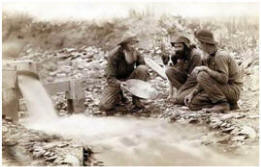 Miners in California used a variety of methods to extract gold. The simplest
method was panning. Squatting by the side of a river or a stream, the miner
filled a shallow, flat-bottomed pan with what he hoped would be "pay dirt." Then
he held the pan under the surface of the water and swirled it about with a
gently rotating motion for several minutes. With one side of the pan held lower
than the other, the water washed away the lighter dirt and sand. The heavier
gold particles-if any-would remain in the bottom of the pan.
Miners in California used a variety of methods to extract gold. The simplest
method was panning. Squatting by the side of a river or a stream, the miner
filled a shallow, flat-bottomed pan with what he hoped would be "pay dirt." Then
he held the pan under the surface of the water and swirled it about with a
gently rotating motion for several minutes. With one side of the pan held lower
than the other, the water washed away the lighter dirt and sand. The heavier
gold particles-if any-would remain in the bottom of the pan.
Panning was a tedious and back-breaking job. Miners improved on this simple method by using a rocker, an oblong box without a top, several feet in length, mounted on rockers like a child's cradle and placed in a sloping position. Pay dirt was shoveled into the rocker, followed by buckets of water. As the miner vigorously rocked the cradle back and forth, the muddy water rushed through and the gold was trapped behind "riffles" or cleats in the bottom of the rocker.
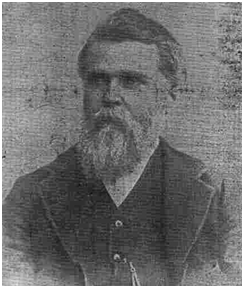 Perry W. McAdow
(Bud) was among the Billings’ area first settlers and real estate dealers. He is
probably best known of the Montana gold mining men. He arrived in Fort Owen
[Bitterroot Valley of Western Montana] in July, 1861. He went on to
Portland, and returned to Montana with Major Owens in the fall. Later in
December he and his future partner A. S. Blake started prospecting for gold in
the dry gulches near Deer Lodge. At Gold Creek they found gold, but cold weather
and snow forced them to seek Fort Owen for shelter. Early in the spring of 1862
they returned and found placer gold at Pioneer Gulch (the first in Montana),
causing a flood of prospectors to come to the site in droves of wagon trains.
Next he moved
to Grasshopper Creek which in turn led to Bannack and Bill Fairweather’s May 26,
1863, discovery of gold at Alder Gulch, richest gold strike in the state.
Perry subsequently filed mining claims at Fort Maginnis, near the town of
Maiden [now a ghost town]. His arrival in the Clark’s Fork Valley area is
not documented. Before Coulson was named as a town, he operated his store (also
referred to as “Coulson”) from a tent presumably on his property, as did a few
others until after September 1877. The Nez Perce Indians, retreating toward
Canada, burned a saloon tent, near his store, at that time.
Perry W. McAdow
(Bud) was among the Billings’ area first settlers and real estate dealers. He is
probably best known of the Montana gold mining men. He arrived in Fort Owen
[Bitterroot Valley of Western Montana] in July, 1861. He went on to
Portland, and returned to Montana with Major Owens in the fall. Later in
December he and his future partner A. S. Blake started prospecting for gold in
the dry gulches near Deer Lodge. At Gold Creek they found gold, but cold weather
and snow forced them to seek Fort Owen for shelter. Early in the spring of 1862
they returned and found placer gold at Pioneer Gulch (the first in Montana),
causing a flood of prospectors to come to the site in droves of wagon trains.
Next he moved
to Grasshopper Creek which in turn led to Bannack and Bill Fairweather’s May 26,
1863, discovery of gold at Alder Gulch, richest gold strike in the state.
Perry subsequently filed mining claims at Fort Maginnis, near the town of
Maiden [now a ghost town]. His arrival in the Clark’s Fork Valley area is
not documented. Before Coulson was named as a town, he operated his store (also
referred to as “Coulson”) from a tent presumably on his property, as did a few
others until after September 1877. The Nez Perce Indians, retreating toward
Canada, burned a saloon tent, near his store, at that time.
He purchased 457.86 acres of land (Desert Claim Land identified later by land surveyors in 1878) south of the Coulson area (Josephine Park – City Water Plant sites, directly south of John Alderson’s land), whose property was used for creation of Coulson. He did claim ownership of these lands prior to the arrival of Northern Pacific railroad and had tried unsuccessfully, along with John Alderson and John Shock, to sell their land to the railroad at an exorbitant price of $30,000 for establishment of a permanent town in Coulson, which was later platted in 1881 by Alderson. He located his land in the summer of 1876, when the railroad surveyors were creating boundary lines.
After Billings was created, McAdow was asked to sell about 300 acres to support Billings. This was later known as “McAdow Subdivision.” The attempt by Alderson to create a town out of Coulson failed, and the town of Billings was created adjacent to it. On June 22, 1885 he granted right-of-way to the Billings Water Power Company to install pipes and ditches on his land. The ditch connected to the Yellowstone River was called Coulson Ditch. Perry was operating a sawmill, with virtually all of his output devoted to the railroad’s needs. The arrival date of the sawmill has not been identified, but had to have been before September 1877.
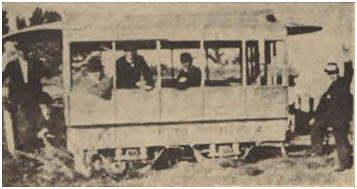 When Billings
became a real town, Perry created a streetcar connection between Coulson and
Billings. He operated two horse-drawn coaches, and offered patrons ‘FREE BEER’
at his
Coulson store
in exchange for
the two-bit ride. This track ran from the railroad at 27th Street
down to 6th Avenue South, then northeast to the town’s Main Street.
Perry, along with T. S. Wadsworth and George B. Hulme (originally from
New York City), formed the “Billings Street Car Company” on 25 May 1882.
The organization of the company took place on the 20th. Its function
was to serve residents and merchants with trade and passage in the City of
Billings. This line was the first in Montana, and ran from 27th
Street & Minnesota Avenue south to 6th Street, then northwest to
where the Conoco refinery is located, and into Coulson’s Main Street.
The total distance was two miles. The town of Coulson lay adjacent to
Billings, and was only a few blocks actual travel to its edges. Extensive lines
were later created that essentially created the bus line routes as currently in
use. Perry McAdow and Fred H. Foster jointly owned the McAdow store, founded in
1881 and placed on the Coulson land at the north edge of the tract. This
partnership lasted until 1883. Joining them was Jules Breuchard, who bought
supplies for Perry on his trip east in 1881 to get married. (Both Jules and Fred
were employed by the NPR at the time.) The local mail carrier, Billy Needham,
upon completing his last trip with the Lavina stage made arrangements to go back
to live with his mother in the east. He pulled off his coat in McAdow’s store
and accidentally dropped a pistol he carried in a pocket. The gun went off
wounding him in the leg, and he died a month later.
When Billings
became a real town, Perry created a streetcar connection between Coulson and
Billings. He operated two horse-drawn coaches, and offered patrons ‘FREE BEER’
at his
Coulson store
in exchange for
the two-bit ride. This track ran from the railroad at 27th Street
down to 6th Avenue South, then northeast to the town’s Main Street.
Perry, along with T. S. Wadsworth and George B. Hulme (originally from
New York City), formed the “Billings Street Car Company” on 25 May 1882.
The organization of the company took place on the 20th. Its function
was to serve residents and merchants with trade and passage in the City of
Billings. This line was the first in Montana, and ran from 27th
Street & Minnesota Avenue south to 6th Street, then northwest to
where the Conoco refinery is located, and into Coulson’s Main Street.
The total distance was two miles. The town of Coulson lay adjacent to
Billings, and was only a few blocks actual travel to its edges. Extensive lines
were later created that essentially created the bus line routes as currently in
use. Perry McAdow and Fred H. Foster jointly owned the McAdow store, founded in
1881 and placed on the Coulson land at the north edge of the tract. This
partnership lasted until 1883. Joining them was Jules Breuchard, who bought
supplies for Perry on his trip east in 1881 to get married. (Both Jules and Fred
were employed by the NPR at the time.) The local mail carrier, Billy Needham,
upon completing his last trip with the Lavina stage made arrangements to go back
to live with his mother in the east. He pulled off his coat in McAdow’s store
and accidentally dropped a pistol he carried in a pocket. The gun went off
wounding him in the leg, and he died a month later.
Rimrock Opera wishes to thank the following major sponsors who make this production possible:
Henrietta Johnstone
Horizon Airlines
Laurel Ford, Steve Solberg
West Park Plaza, LePriel White
ABCO Supply, Inc., Gail Hein, Susie Loran
Billings Cultural Partners
Billings Gazette; Jaci Webb, Maureen Turpin, Dan Berry,
Melanie Fabrizius, Stacy Just
Country Inn & Suites
Billings Outpost
Q2 Television
Community Seven TV
Domino’s Pizza
Granny’s Attic
James W. Thompson & Staff
KEMC-91.7 FM Yellowstone Public Radio
Montana State University-Billings
OZ Fitness, Charlie Coe, Manager
Pierce Leasing
PostNet, Kelly & Carol Sanders
Rattlesnake Valley Press, Dennis Kern, Photographer & Web Manager
Rocky Mountain College
PPL Montana
Smith Funeral Chapels, Inc.
Dude Rancher Lodge
Big Sky Airlines
Spotlight Productions, Anne Gauer, archive videographer
Buchanan Capitol